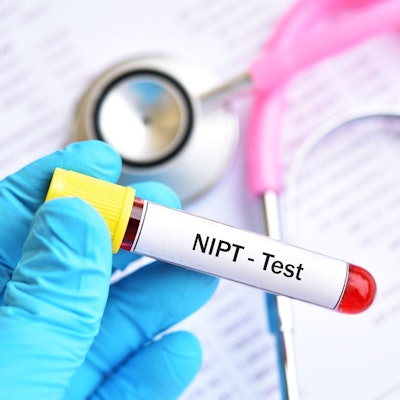
Noninvasive prenatal testing (NIPT) is better than conventional testing for Down syndrome, but its high cost must come down to make it more viable as a first-tier screening test, according to a Canadian study published on December 4 in PLOS One.
Investigators at St. Paul's Hospital and at the University of British Columbia, both located in Vancouver, developed a microsimulation decision-analytic model that they used to perform a probabilistic cost-effective analysis (CEA) of prenatal screening and diagnostic strategies for Down syndrome -- the most common fetal chromosomal abnormality. For the analysis, they assumed a price of $490 for NIPT and they considered a wide range of factors, including testing accuracy, the cost of consultations, and the need for follow-up tests.
Compared with contingent NIPT (NIPT as a second-tier screening test to follow up on a questionable finding with a traditional test), universal NIPT as a first-tier screening test is not cost-effective at its current price, senior author and health economist Aslam Anis, PhD, director of the Centre for Health Evaluation & Outcome Sciences (CHÉOS) at the University of British Columbia, and colleagues wrote. This conclusion is based on an incremental cost-effectiveness ratio of more than $100,000 per quality-adjusted life year (QALY). Moreover, contingent NIPT also had the lowest cost per case of Down syndrome.
Where does NIPT fit in?
Noninvasive prenatal testing is more accurate than traditional serum biochemical and nuchal translucency screening tests for fetal anomalies and, consequently, is less likely to result in invasive follow-up tests. But the higher price tag affects decisions about using it upfront.
For the study, the researchers used their model to follow simulated pregnant women through their pregnancy period. The model included three comparators: serum-only screening, contingent NIPT, and universal NIPT. To address uncertainty around the model, the researchers used a Monte Carlo simulation to obtain the expected values of costs and QALYs in the base case and in all scenario analyses.
The investigators conducted base case and scenario analyses by repeating the microsimulation 1,000 times for a sample of 45,605 pregnant women from the 4.8 million population of British Columbia.
Based on the results of the CEA, contingent NIPT dominated over the serum-only strategy. The contingent strategy yielded a lower long-term cost, a lower cost per case detected, and a slightly greater QALY gain (or a lower QALY loss). The long-term cost of universal NIPT per pregnant woman was $507, compared with $314 for contingent NIPT, the investigators reported.
Utilizing universal NIPT as a first-tier screening test yielded a small gain, or less of a loss, in QALY -- 0.0925 QALY loss in contingent NIPT versus 0.0918 for universal NIPT. But at the willingness-to-pay threshold of $50,000 per QALY gained, universal NIPT was only cost-effective in 5% of the runs.
The use of universal NIPT resulted in more detected cases of Down syndrome than did contingent NIPT. On average, 117 cases were detected with universal NIPT, compared with 108 cases using contingent NIPT. Taking into account costs until the end of pregnancy, costs for each detected case totaled $124,076 for universal NIPT, compared with $47,210 for contingent NIPT.
"By employing a microsimulation model instead of a cohort-based model, we accommodated the heterogeneity among pregnant women and were able to track their individual pathways," the authors wrote. "Furthermore, the information we used, such as maternal age distribution, maternal age-specific update rate of screening, and costs of [healthcare] services, were obtained from the most recent data sources as well as real-world observations."



















